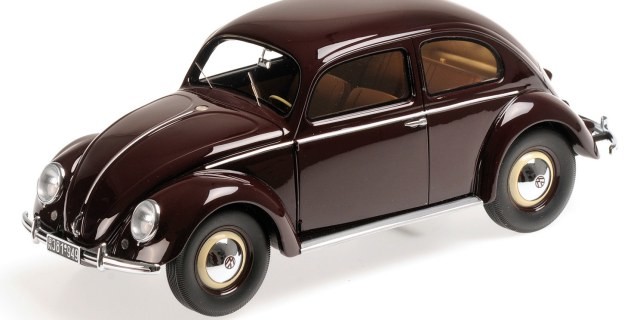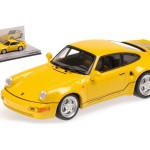Minichamps is back, and this time with photos! The latest litter from the Minichamps camp include five new releases. The feature in the 1:18 diecast 1949 Volkswagen 1200 in deep Ruby Red with Tan interior. It’s gorgeous! Other new models by scale are as follows:
1:18 – ALFA ROMEO 8C 2900 B LUNGO – 1938 – BLACK (resin)
1:18 – FORD FOCUS ST – 2011 – WHITE L.E. 504 pcs. (diecast)
1:43 – OPEL OMEGA (A) 3000 24V – IRMSCHER ´ATS´ – VOLKER STRYCEK – DTM 1991 L.E. 1008 pcs.
1:43 – PORSCHE 911 TURBO S 3.3 (964) – ´LEICHTBAU´ – 1992 – YELLOW L.E. 1008 pcs.
About the Beetle… “The VW Beetle (VW Type 1) is a passenger car model of the lower middle class of the Volkswagen brandwith an air-cooled four-cylinder boxer engine and rear-wheel drive, which was built from the end of 1938 until the Summer of 2003. With excess of 21.5 million vehicles, the Beetle was the bestselling car in the world before it was surpassed by the VW Golf in June 2002. The origins of the VW Beetle date back to the government efforts of the National Socialistic Germany for the creation of an affordable Volkswagen, for a broad section of the population,which was called KdF car. Ferdinand Porsche who is commonly referred to as the creator of the Beetle, contributed largely to its development. However, it was not only the idea of a technically simple and economically produced Volkswagen, in principle older than his development at the NS time also the technical concept of rear-wheel drive and rear oscillating axle was not new.
The KdF car was not produced in series before the World War II because the Volkswagen factory in Fallersleben (presently a suburb of Wolfsburg) that was established in May 1938 was not yet competed. During the war, military vehicles and other armaments were manufactured, therefore the serial production of the then called Volkswagen car could only commence in the summer of 1945. Until the end of 1945 1785 vehicles were manufactured and delivered to the occupying forces as well as the German Post. As from 1946, the Volkswagen could be bought privately with a coupon for the price Reichsmark 5000 (current value 18 000 Euro).
With the export to the USA and many other countries and as a result of the so-called German economic miracle, the Volkswagen was symbolical and Beetle production in Wolfsburg and many production and assembly plants around the world reached new heights. In the USA – after Germany the main VW market – the Beetle was perceived as a cheap and economical vehicle and especially as a %u201Ccounter culture%u201D to the popular street cruisers in the 1960%u2019s. In the early 1970%u2019s the marketing distribution dropped due to competition from other small modern cars.
With the start of production of the successor VW Golf I the Beetle manufacturing in Wolfsburg was stopped mid-1974; the plant in Emden manufactured the Beetle-Limousine until the beginning of 1978. Thereafter the vehicle was only produced in Mexico and Brazil and supplied by VW in Germany until 1985. The production of the convertibles by Karmann in Osnabrück was halted in January 1980. In July 2003 the last Beetle rolled of the conveyor belt. Altogether 21 529 464 VW Beetles were manufactured; thereof almost 15.8 million vehicles were produced (including approximately 330 000 convertibles) in Germany. The body shape|style of the VW New Beetle which was manufactured in Mexico (1998 until 2010) and the successor VW Beetle (2011) are modeled similar to the original Beetle.”







